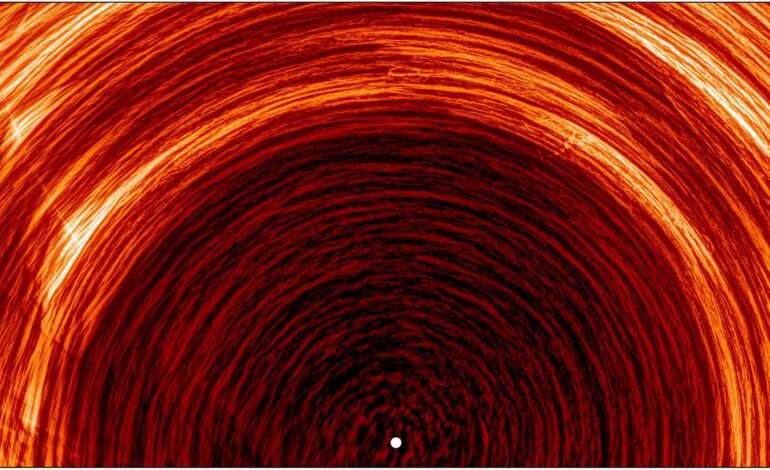Solar Orbiter Reveals Surprising Magnetic Activity at Sun’s Poles

The European Space Agency’s Solar Orbiter has provided scientists with an unprecedented close-up view of the sun’s magnetic field, particularly near its south pole. This groundbreaking observation highlights unexpected behaviors in the sun’s magnetic structures, which are moving toward the sun’s edge at significantly higher speeds than previously estimated. The findings were detailed in a paper published on November 5 in The Astrophysical Journal Letters.
During its observations in March 2025, Solar Orbiter captured a composite image over eight days, showcasing bright arcs that trace the movement of magnetic structures. These arcs are indicative of a dynamic process occurring as the sun’s magnetic field migrates toward its poles much faster than scientists anticipated. According to Sami Solanki, a director at the Max Planck Institute for Solar System Research and co-author of the study, understanding the sun’s magnetic cycle requires comprehensive knowledge of the poles, which Solar Orbiter is now able to provide.
The sun’s magnetism operates on an approximately 11-year cycle, during which magnetic fields undergo twisting, flipping, and rebuilding. This cycle is responsible for phenomena such as sunspots, solar flares, and solar storms that can impact Earth. Central to this process is a slow-moving “magnetic conveyor belt” that transports plasma currents carrying magnetic field lines from the equator to the poles and back. Despite its significance, the polar regions have remained largely unexplored due to the challenges posed by direct observation from Earth.
Solar Orbiter’s innovative tilt of 17 degrees in March 2025 has allowed researchers to observe the sun’s southern limb directly. In this study, Solanki and his team utilized two key instruments onboard the spacecraft: the Polarimetric and Helioseismic Imager (PHI) and the Extreme Ultraviolet Imager (EUI). Together, these tools effectively map the movement of hot plasma and magnetic fields across the solar surface, focusing on the chromosphere where magnetic networks leave identifiable imprints.
The results indicate that enormous supergranules—massive bubbles of swirling plasma—sweep magnetic fields toward the poles at speeds ranging from 20 to 45 miles per hour (32 to 72 kilometers per hour). This velocity is comparable to similar flows observed closer to the equator but surpasses previous model predictions. Researcher Lakshmi Pradeep Chitta highlighted that the supergranules serve as tracers, revealing the polar component of the sun’s global circulation for the first time.
The implications of this research mark what the authors describe as “a new era” in exploring the sun’s polar regions. This study provides crucial data that enhances our understanding of the mechanisms powering the solar cycle and the magnetic field that influences the entire solar system. As Solar Orbiter continues its mission, it promises to unlock further mysteries of our nearest star and its complex behavior.






